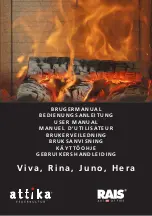
- 12 -
E
N
G
L
IS
H
3 . I N S T A L L A T I O N O F T H E S T O V E
Ensure that the deflector plate (page 4-5, part 17) is
correctly positioned prior to initial commissioning and
after relocation, cleaning and service work.
The damper flap must be open in the flue pipe.
Ensure with this stove that the chimney draught
reaches at least the value specified (10 Pa).
If there are any problems with this, contact
your master chimney sweep.
CONNECTING THE STOVE
Proceed as follows for new connections in a brick-built
chimney:
1. Measure and mark out the stove connection (take into
consideration any floor plate thickness) according to
natural dimensions.
2. Chisel out (drill) the hole in the brickwork.
3. Brick in the wall liner.
Seal the wall liner first with mineral rock wool. Render
with heat-resistant cement mortar or equivalent.
4. Position the floor plate with floor protection (cardboard)
once the mortar has set and after painting.
5. The stove can now be carefully lifted onto the floor plate.
The stove should not be pushed on unprotected
floors.
Strong corrugated cardboard or e.g. old carpet is
useful to assist assembly and as a base. The stove
can also be pushed on this cardboard or carpet.
We recommend original flue pipes from RIKA for proper
connection.
The connection may not project into the chimney shaft!
Seal the gap between flue pipe and wall liner with ceramic
sealer.
The installation must conform to the respective safety
and building regulations.
Please contact your master chimney sweep in this
context. He will be pleased to inform you.
If you use a system chimney (e.g. glazed fireclay) we
would ask you follow the manufacturer’s connection
instructions closely.
EXTERNAL
COMBUSTION AIR INLET
(OPTIONAL)
- The scope of supply does not include the intake nozzle
(page 4-5, part 6).
- Connect to the intake nozzle a pipe Ø125 (e.g. steel
spiral or HT pipe) and fix this (not included in scope of
supply!)
- The air supply line must be gas-tight for ambient air
independent operation. (Apply heat-resistant silicone all
around the joints).
The air line, which should be provided with a shut-off valve
close to the stove, should not be longer than 4m or have
more than 3 bends.
- If the line leads outside it must have a windbreak.
Summary of Contents for Vitra Passivehouse
Page 1: ...1 Instruction Manual Vitra Passivehouse Instruction Manual...
Page 2: ...2...
Page 3: ...3 D I M E N S I O N S...
Page 4: ...4 S P A R E P A R T O V E R V I E W...
Page 19: ...19...






































